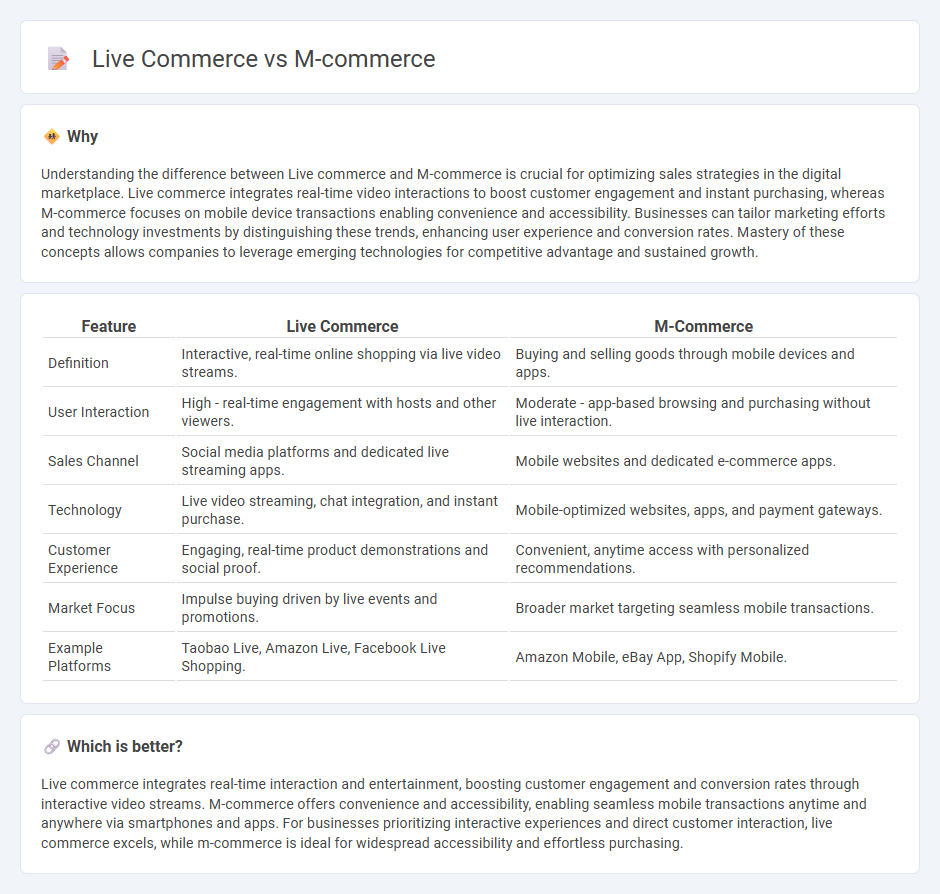
Live commerce integrates real-time video streaming with online shopping, allowing consumers to interact with hosts and make instant purchases. M-commerce, or mobile commerce, focuses on buying and selling goods through mobile devices, optimizing user experience for smartphones and tablets. Discover the unique advantages and trends shaping the future of Live commerce and M-commerce now.
Why it is important
Understanding the difference between Live commerce and M-commerce is crucial for optimizing sales strategies in the digital marketplace. Live commerce integrates real-time video interactions to boost customer engagement and instant purchasing, whereas M-commerce focuses on mobile device transactions enabling convenience and accessibility. Businesses can tailor marketing efforts and technology investments by distinguishing these trends, enhancing user experience and conversion rates. Mastery of these concepts allows companies to leverage emerging technologies for competitive advantage and sustained growth.
Comparison Table
| Feature | Live Commerce | M-Commerce |
|---|---|---|
| Definition | Interactive, real-time online shopping via live video streams. | Buying and selling goods through mobile devices and apps. |
| User Interaction | High - real-time engagement with hosts and other viewers. | Moderate - app-based browsing and purchasing without live interaction. |
| Sales Channel | Social media platforms and dedicated live streaming apps. | Mobile websites and dedicated e-commerce apps. |
| Technology | Live video streaming, chat integration, and instant purchase. | Mobile-optimized websites, apps, and payment gateways. |
| Customer Experience | Engaging, real-time product demonstrations and social proof. | Convenient, anytime access with personalized recommendations. |
| Market Focus | Impulse buying driven by live events and promotions. | Broader market targeting seamless mobile transactions. |
| Example Platforms | Taobao Live, Amazon Live, Facebook Live Shopping. | Amazon Mobile, eBay App, Shopify Mobile. |
Which is better?
Live commerce integrates real-time interaction and entertainment, boosting customer engagement and conversion rates through interactive video streams. M-commerce offers convenience and accessibility, enabling seamless mobile transactions anytime and anywhere via smartphones and apps. For businesses prioritizing interactive experiences and direct customer interaction, live commerce excels, while m-commerce is ideal for widespread accessibility and effortless purchasing.
Connection
Live commerce integrates real-time video streaming with e-commerce platforms, enhancing customer engagement and driving immediate purchases through interactive experiences. M-commerce, or mobile commerce, enables consumers to shop via smartphones and tablets, making live commerce accessible anytime and anywhere. The synergy between live commerce and m-commerce amplifies convenience and personalization, leading to increased conversion rates and higher customer retention in the digital retail landscape.
Key Terms
Mobile Apps
M-commerce leverages mobile apps to facilitate seamless shopping experiences, enabling quick product browsing, secure payments, and personalized recommendations directly on smartphones. Live commerce integrates real-time interactive video streaming within mobile apps, enhancing consumer engagement through live demonstrations, instant purchases, and social interaction features. Explore the distinctive advantages and trends of both mobile app-driven commerce strategies to optimize your digital sales approach.
Real-time Interaction
M-commerce leverages mobile devices to enable seamless shopping anytime and anywhere, prioritizing convenience and personalized experiences through app-based or mobile-optimized platforms. Live commerce enhances engagement by integrating real-time video streaming with instant purchasing options, creating interactive sessions where consumers can ask questions and receive immediate feedback from hosts or sellers. Explore how these evolving commerce models maximize real-time interaction to transform consumer behavior and retail strategies.
Social Media Platforms
M-commerce leverages mobile devices to facilitate seamless online shopping experiences, integrating payment systems directly into apps like Instagram and Facebook. Live commerce enhances this by combining real-time video streaming with interactive purchasing, prominently used on platforms such as TikTok and Facebook Live to engage audiences and drive instant sales. Explore how integrating m-commerce and live commerce on social media can revolutionize your retail strategy.
Source and External Links
What is m-commerce vs. e-commerce? - Adjust - M-commerce is a subset of e-commerce that involves buying and selling goods and services specifically through mobile apps on smartphones and tablets.
M-Commerce: Applications, Advantages & Disadvantages - Carmatec - M-commerce enables users to shop, make payments, book tickets, and access services via mobile devices and includes applications such as retail shopping apps, mobile banking, travel booking apps, and entertainment streaming.
The Rise of M-Commerce: Why Mobile is the Future of Online ... - M-commerce is reshaping consumer shopping by providing a mobile-first experience with intuitive payment systems and touch-friendly navigation, accounting for over half of online browsing and nearly half of e-commerce transactions made via mobile wallets.
 dowidth.com
dowidth.com